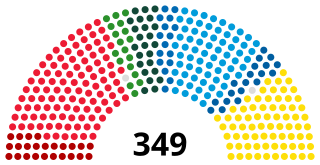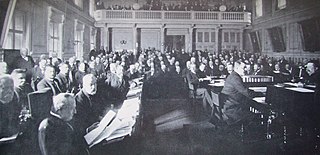
Suffrage, political franchise, or simply franchise is the right to vote in public, political elections and referendums. In some languages, and occasionally in English, the right to vote is called active suffrage, as distinct from passive suffrage, which is the right to stand for election. The combination of active and passive suffrage is sometimes called full suffrage.

A member of parliament (MP) is the representative in parliament of the people who live in their electoral district. In many countries with bicameral parliaments, this term refers only to members of the lower house since upper house members often have a different title. The terms congressman/congresswoman or deputy are equivalent terms used in other jurisdictions. The term parliamentarian is also sometimes used for members of parliament, but this may also be used to refer to unelected government officials with specific roles in a parliament and other expert advisers on parliamentary procedure such as the Senate parliamentarian in the United States. The term is also used to the characteristic of performing the duties of a member of a legislature, for example: "The two party leaders often disagreed on issues, but both were excellent parliamentarians and cooperated to get many good things done."

Kalix Municipality is a municipality in Norrbotten County in northern Sweden. Its seat is located in Kalix.

Gnesta Municipality is a municipality in Södermanland County in southeast Sweden. Its seat is located in the town of Gnesta, with some 5,000 inhabitants.

Karlstad Municipality is a municipality in Värmland County in west central Sweden. Its seat is located in the city of Karlstad.

The Riksdag is the legislature and the supreme decision-making body of Sweden. Since 1971, the Riksdag has been a unicameral legislature with 349 members, elected proportionally and serving, since 1994, fixed four-year terms. The 2022 Swedish general election is the most recent general election.

The Parliament of Finland is the unicameral and supreme legislature of Finland, founded on 9 May 1906. In accordance with the Constitution of Finland, sovereignty belongs to the people, and that power is vested in the Parliament. The Parliament consists of 200 members, 199 of whom are elected every four years from 13 multi-member districts electing 7 to 36 members using the proportional D'Hondt method. In addition, there is one member from Åland.

In Swedish and Finnish history, the Age of Liberty was a period that saw parliamentary governance, increasing civil rights, and the decline of the Swedish Empire that began with the adoption of the Instrument of Government in 1719 and ended with Gustav III's self-coup in 1772. This shift of power from the monarch to parliament was a direct effect of the Great Northern War.

The period following the accession of Oscar II to the throne of Sweden in 1872 was marked by political conflict. The Lantmanna Party, representing peasant proprietors, dominated the Lower House of parliament, and demanded tax reductions and reforms of the system of military service. The Upper House opposed these positions. A compromise was reached in 1884 with reduction in land taxes and increased periods of military service, processes that continued in later years.

The estates of the realm, or three estates, were the broad orders of social hierarchy used in Christendom from the Middle Ages to early modern Europe. Different systems for dividing society members into estates developed and evolved over time.
New Democracy was a political party in Sweden. It was founded in 1991 and elected into the Riksdag in the 1991 Swedish general election. It lost all its seats in the Riksdag in the subsequent election in 1994, and its subsequent decline culminated in bankruptcy in February 2000, at which time it retained only one city council post. Local factions of New Democracy reformed into minor parties such as Sjöbopartiet, which faced mixed success.

The Diet of Finland, was the legislative assembly of the Grand Duchy of Finland from 1809 to 1906 and the recipient of the powers of the Swedish Riksdag of the Estates.

The Prussian three-class franchise was an indirect electoral system used from 1848 until 1918 in the Kingdom of Prussia and for shorter periods in other German states. Voters were grouped by district into three classes, with the total tax payments in each class equal. Those who paid the most in taxes formed the first class, followed by the next highest in the second, with those who paid the least in the third. Voters in each class separately elected one third of the electors who in turn voted for the representatives. Voting was not secret. The franchise was a form of apportionment by economic class rather than geographic area or population.
The State of New Hampshire has a republican form of government modeled after the Government of the United States, with three branches: the executive, consisting of the Governor of New Hampshire and the other elected constitutional officers; the legislative, called the New Hampshire General Court, which includes the Senate and the House of Representatives; and the judicial, consisting of the Supreme Court of New Hampshire and lower courts.

Early general elections were held in Sweden between 10 and 26 September 1921. In the first elections held under universal suffrage, the Swedish Social Democratic Party remained the largest party, winning 93 of the 230 seats in the Second Chamber of the Riksdag. Party leader Hjalmar Branting formed his second government.

The Union between Sweden and Norway is an overriding theme of the history of Sweden in the 19th century. On 4 November 1814, the kingdoms of Sweden and Norway formed a personal union under one king. The two countries had completely separate institutions, except for the foreign service led by the king through the Swedish foreign minister.

The Andra kammaren was the lower house of the bicameral Riksdag of Sweden between 1866 and 1970 that replaced the Riksdag of the Estates. The upper house was the Första kammaren.

General elections were held in Sweden in 1869 to elect the Second Chamber of the Riksdag for a three-year term. In urban areas the elections were direct, whilst in some rural areas the vote was indirect, using electors.

General elections were held in Sweden in 1872 to elect the Second Chamber of the Riksdag for a three-year term. Following the elections, the Lantmanna Party was the largest party, holding 90 of the 194 seats.

General elections were held in Sweden in 1875 to elect the Second Chamber of the Riksdag for a three-year term. Following the elections, the Lantmanna Party remained the largest party, holding 92 of the 198 seats.
















